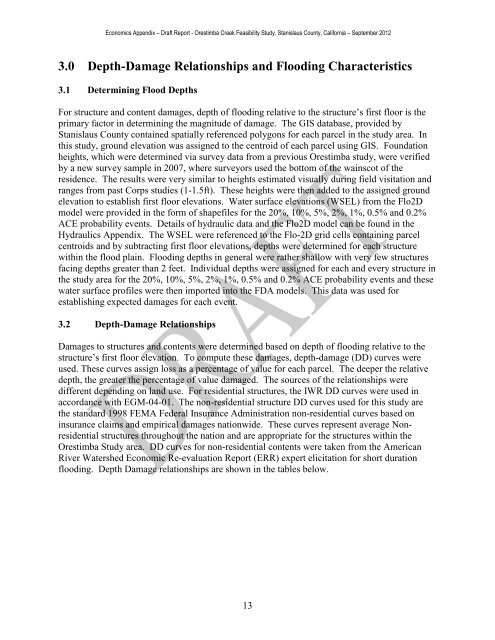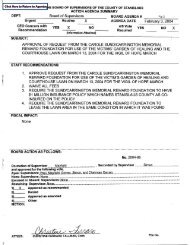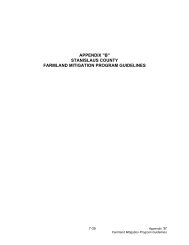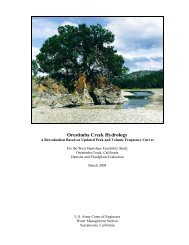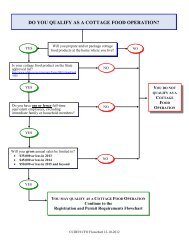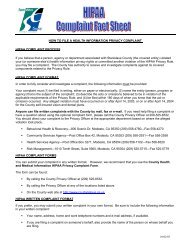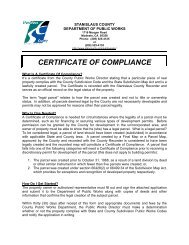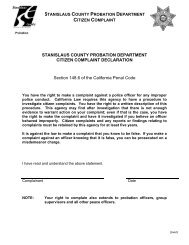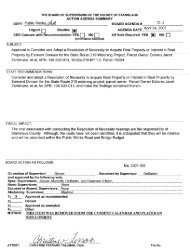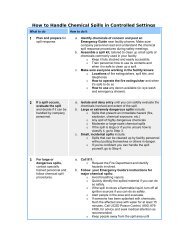Orestimba Creek Feasibility Study - Stanislaus County
Orestimba Creek Feasibility Study - Stanislaus County
Orestimba Creek Feasibility Study - Stanislaus County
You also want an ePaper? Increase the reach of your titles
YUMPU automatically turns print PDFs into web optimized ePapers that Google loves.
Economics Appendix – Draft Report - <strong>Orestimba</strong> <strong>Creek</strong> <strong>Feasibility</strong> <strong>Study</strong>, <strong>Stanislaus</strong> <strong>County</strong>, California – September 2012<br />
3.0 Depth-Damage Relationships and Flooding Characteristics<br />
3.1 Determining Flood Depths<br />
For structure and content damages, depth of flooding relative to the structure’s first floor is the<br />
primary factor in determining the magnitude of damage. The GIS database, provided by<br />
<strong>Stanislaus</strong> <strong>County</strong> contained spatially referenced polygons for each parcel in the study area. In<br />
this study, ground elevation was assigned to the centroid of each parcel using GIS. Foundation<br />
heights, which were determined via survey data from a previous <strong>Orestimba</strong> study, were verified<br />
by a new survey sample in 2007, where surveyors used the bottom of the wainscot of the<br />
residence. The results were very similar to heights estimated visually during field visitation and<br />
ranges from past Corps studies (1-1.5ft). These heights were then added to the assigned ground<br />
elevation to establish first floor elevations. Water surface elevations (WSEL) from the Flo2D<br />
model were provided in the form of shapefiles for the 20%, 10%, 5%, 2%, 1%, 0.5% and 0.2%<br />
ACE probability events. Details of hydraulic data and the Flo2D model can be found in the<br />
Hydraulics Appendix. The WSEL were referenced to the Flo-2D grid cells containing parcel<br />
centroids and by subtracting first floor elevations, depths were determined for each structure<br />
within the flood plain. Flooding depths in general were rather shallow with very few structures<br />
facing depths greater than 2 feet. Individual depths were assigned for each and every structure in<br />
the study area for the 20%, 10%, 5%, 2%, 1%, 0.5% and 0.2% ACE probability events and these<br />
water surface profiles were then imported into the FDA models. This data was used for<br />
establishing expected damages for each event.<br />
3.2 Depth-Damage Relationships<br />
Damages to structures and contents were determined based on depth of flooding relative to the<br />
structure’s first floor elevation. To compute these damages, depth-damage (DD) curves were<br />
used. These curves assign loss as a percentage of value for each parcel. The deeper the relative<br />
depth, the greater the percentage of value damaged. The sources of the relationships were<br />
different depending on land use. For residential structures, the IWR DD curves were used in<br />
accordance with EGM-04-01. The non-residential structure DD curves used for this study are<br />
the standard 1998 FEMA Federal Insurance Administration non-residential curves based on<br />
insurance claims and empirical damages nationwide. These curves represent average Nonresidential<br />
structures throughout the nation and are appropriate for the structures within the<br />
<strong>Orestimba</strong> <strong>Study</strong> area. DD curves for non-residential contents were taken from the American<br />
River Watershed Economic Re-evaluation Report (ERR) expert elicitation for short duration<br />
flooding. Depth Damage relationships are shown in the tables below.<br />
13


